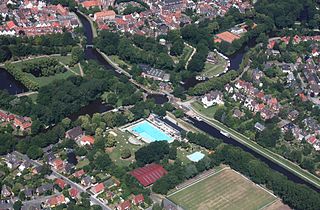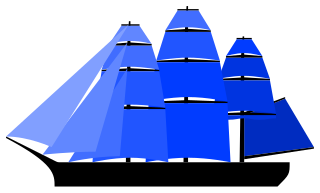The Volkswagen Passat is a series of large family cars built since 1973 named after the German word for "trade wind".
Passat may also refer to:
The Volkswagen Passat is a series of large family cars built since 1973 named after the German word for "trade wind".
Passat may also refer to:

Emden is an independent city and seaport in Lower Saxony in the northwest of Germany, on the river Ems. It is the main city of the region of East Frisia and, in 2011, had a total population of 51,528.

Dhow is the generic name of a number of traditional sailing vessels with one or more masts with settee or sometimes lateen sails, used in the Red Sea and Indian Ocean region. Typically sporting long thin hulls, dhows are trading vessels primarily used to carry heavy items, such as fruit, fresh water, or other heavy merchandise, along the coasts of Eastern Arabia, East Africa, Yemen and coastal South Asia. Larger dhows have crews of approximately thirty, smaller ones typically around twelve.

In geography and seamanship, Windward and leeward are directions relative to the wind. Windward is upwind from the point of reference, i.e. towards the direction from which the wind is coming; leeward is downwind from the point of reference, i.e. along the direction towards which the wind is going.

The Bay of Lübeck is a basin in the southwestern Baltic Sea, off the shores of the German states of Mecklenburg-Vorpommern and Schleswig-Holstein. It forms the southwestern part of the Bay of Mecklenburg.

The Volkswagen Passat is a series of large family cars manufactured and marketed by the German automobile manufacturer Volkswagen since 1973, and now in its eighth generation. It has been marketed variously as the Dasher, Santana, Quantum, Magotan, Corsar and Carat. The successive generations of the Passat carry the Volkswagen internal designations B1, B2, etc.

The Flying P-Liners were the sailing ships of the German shipping company F. Laeisz of Hamburg.

Pamir was a four-masted barque built for the German shipping company F. Laeisz. One of their famous Flying P-Liners, she was the last commercial sailing ship to round Cape Horn, in 1949. By 1957, she had been outmoded by modern bulk carriers and could not operate at a profit. Her shipping consortium's inability to finance much-needed repairs or to recruit sufficient sail-trained officers caused severe technical difficulties. On 21 September 1957, she was caught in Hurricane Carrie and sank off the Azores, with only six survivors rescued after an extensive search.

On a square rigged ship, the spanker is a gaff-rigged fore-and-aft sail set from, and aft of, the aftmost mast. Spankers are also called driver, jigger, and a pusher sail.

Iron-hulled sailing ships represented the final evolution of sailing ships at the end of the age of sail. They were built to carry bulk cargo for long distances in the nineteenth and early twentieth centuries. They were the largest of merchant sailing ships, with three to five masts and square sails, as well as other sail plans. They carried lumber, guano, grain or ore between continents. Later examples had steel hulls. They are sometimes referred to as "windjammers" or "tall ships". Several survive, variously operating as school ships, museum ships, restaurant ships, and cruise ships.
A sea lane, sea road or shipping lane is a regularly used navigable route for large water vessels (ships) on wide waterways such as oceans and large lakes, and is preferably safe, direct and economic. During the Age of Sail, they were determined by the distribution of land masses but also by the prevailing winds, whose discovery was crucial for the success of long maritime voyages. Sea lanes are very important for seaborne trade.

Travemünde is a borough of Lübeck, Germany, located at the mouth of the river Trave in Lübeck Bay. It began life as a fortress built by Henry the Lion, Duke of Saxony, in the 12th century to guard the mouth of the Trave, and the Danes subsequently strengthened it. It became a town in 1317 and in 1329 passed into the possession of the free city of Lübeck, to which it has since belonged. Its fortifications were demolished in 1807.

Passat is a German four-masted steel barque and one of the Flying P-Liners, the famous sailing ships of the German shipping company F. Laeisz. She is one of the last surviving windjammers.

Peking is a steel-hulled four-masted barque. A so-called Flying P-Liner of the German company F. Laeisz, it was one of the last generation of cargo-carrying iron-hulled sailing ships used in the nitrate trade and wheat trade around Cape Horn.
SS Cambridge was a refrigerated steam cargo liner that was built in Germany for the Hamburg America Line. She was launched in 1916 as Vogtland, but after the 1919 Treaty of Versailles the United Kingdom took her as war reparations and sold her to the Federal Steam Navigation Company, who renamed her Cambridge. She operated between Britain and Australasia until 1940, when a German mine sank her off the coast of Australia.

The Last Grain Race is a 1956 book by Eric Newby, a travel writer, about his time spent on the four-masted steel barque Moshulu during the vessel's last voyage in the Australian grain trade.

The Volkswagen Passat for the North American and Chinese markets is a mid-size sedan that debuted in January 2011 at the Detroit Auto Show. It replaced the B6 Passat in the North American market. The Passat NMS was marketed in North America, the Middle East, South Korea and China, with no wagon/estate version available. In China, it is sold alongside the long-wheelbase version of the European Passat known as the Magotan.

Grain Race or The Great Grain Race was the informal name for the annual windjammer sailing season generally from South Australia's grain ports on Spencer Gulf to Lizard Point, Cornwall on the southwesternmost coast of the United Kingdom, or to specific ports. A good, fast passage Australia-to-England via Cape Horn was considered anything under 100 days.

The Volkswagen Chattanooga Assembly Plant is an American automobile assembly plant in Chattanooga, Tennessee. The plant was formally announced in July 2008 and was formally inaugurated in May 2011.

The Volkswagen Passat (B2) is an automobile which was produced by German manufacturer Volkswagen from 1981 to 1988. It was the second generation of the Volkswagen Passat. The platform was slightly longer than the preceding Passat (B1). As with the previous generation, it was based on the platform of the Audi 80; the corresponding B2 version of which had been already launched in 1978. The Santana was also manufactured in China, Brazil, Mexico and Argentina. In Brazil, the Santana station wagon was sold as the Quantum. In the United States, both the Santana sedan and station wagon were sold as the Quantum. The Passat saloon and estate were produced in South Africa for their local market until 1987. The production of Passat B2 in China ended in January 2013.

MV Delphin was a cruise ship owned by the Mauritius-based Vishal Cruises Pvt. Ltd., under charter to the Germany-based Passat Kreuzfahrten. Built 1975 by Oy Wärtsilä Ab Turku Shipyard in Finland and renovated 1986 and 1993 by Lloyd Werft, Bremerhaven, Germany and got converted into a cruise ship, with her bow unloading doors permanently welded. In 1992, while being serviced at Singapore's Singmarine Dockyard, she toppled over when a floating dock sank with her in it. In 1993, she went through renovations at Lloyd-Werft again and got completely modernized and elegantly re-equipped. At the same time, the Delphin Seereisen and later Delphin-owned Hansa Kreuzfahrten of Germany, had been chartered until bankruptcy. The ship was managed by MTC Marine Trade Consulting GmbH.